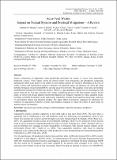| dc.contributor.author | Jonathan M. Munguti1 , James G. Kirimi2 , Kevin O. Obiero3 , Erick O. Ogello4 , Domitila N. Kyule1 , David M. Liti5 & Levi M. Musalia6 | |
| dc.date.accessioned | 2021-06-11T08:53:35Z | |
| dc.date.available | 2021-06-11T08:53:35Z | |
| dc.date.issued | 2021 | |
| dc.identifier.uri | https://repository.maseno.ac.ke/handle/123456789/3981 | |
| dc.description.abstract | Dietary composition of aquaculture feeds (aquafeeds) determines the quality of wastes from aquaculture
production systems. These wastes, which are derived mainly from nitrogenous and phosphorus compounds
subsequently affect water quality in the culture systems and the ambient environment. Depending on the type of
culture systems and management practices employed, the aquafeed wastes can influence the water pH, algal
turbidity, biological oxygen demand (BOD) and may cause fish mortality. The aquafeed wastes also can facilitate
eutrophication leading into harmful algal blooms. Moreover, large quantities of aqua-waste are discharged as fish
cannot retain all the food they consume which means a significant portion of the feed remains uneaten. In this
paper, we review and discuss practical nutritional strategies and mitigation measures to reduce aquafeed wastes
including controlled formulation using high-quality ingredients, enzyme-based aquafeed, processing, reduction
of anti-nutrition factors and precision feeding. The paper further recommends strategies for enhancing the
resilience of aquaculture production systems and mitigation measures to reduce the effects of aqua-wastes on
ambient natural environments. | en_US |
| dc.publisher | Journal of Agricultural Science | en_US |
| dc.subject | aqua-feed, aqua-wastes, nitrogen, nutrient discharge, nutritional strategies, phosphorus | en_US |
| dc.title | Aqua-Feed Wastes: Impact on Natural Systems and Practical Mitigations—A Review | en_US |
| dc.type | Article | en_US |

